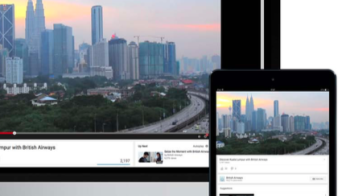Video’s shift to long-form necessitates flexible, cross-device ad content
Gregg Rogers
Gregg Rogers, Global Product Marketing Manager at Sizmek writes alongside Brant Nesbitt, Interactive Design Lead, looking at the shift of video.
In today’s fragmented media landscape, brands are forced to compete with user’s shifting attention spans and a desire for added value. Consumers are savvier than ever, especially when it comes to verticals that have more extensive and detailed purchase funnels, such as auto and electronics. These purchases are sizable commitments to the consumer, so they want as much information as possible before buying.
The ability to deliver interactive messaging has led to new methodologies for assembling video ads. As time spent viewing digital video continues to grow, consumers are becoming drawn to long-form digital content, meaning cramming every bit of information into a 30-second spot is no longer necessary.
Leading brands are already taking advantage of this by creating deeper more immersive video ads. Traditional media has historically taken a linear approach to advertising, but brands are no longer storytellers, they have become experience creators. Brand advertisers need to come up with multiple scenarios and narratives for their video ad campaigns. The goal is to provide insight and value to customers that allow them to make informed purchase decisions. Therefore, video ads must allow the customer to get to know the product and the brand, demonstrating how that product provides value and is worth the consumer’s time.
A non-linear approach allows marketers to create flexible video ad units that can pull viewers into more profound brand engagements. This means considering the key message, scripting, storyboarding, wire-framing and producing content to scale for different user flows and attention spans. Consumers tune out messages that do not connect with them emotionally, according to Dr. Thomas Trautmann, a certified neuromarketing instructor. Therefore, a flexible approach with compelling creative and a clear call-to-action – a teaser or invitation – will entice the audience to activate ads and learn more.
To date, too many brands have been retrofitting online ads to accommodate traditional TV spots. But with the number of digital video viewers predicted to climb to 2.15 billion this year, it’s clear that there is a paradigm shift occurring, and advertisers must take an omni-channel approach to planning their video assets.
By engaging with the ad, the user will likely learn more about the product than they could with a traditional spot. Long-form content also provides an interactive deep-dive of information at the user’s fingertips. Any questions left unaddressed by the supplemental content can then be rectified by a more personalised approach, benefiting brands and consumers alike.
Now that we’ve outlined the benefits of producing video advertising for an interactive, long-form approach, here are some best practices for building these kinds of ad messages:
•Larger, more apparent overlays tend to see stronger results
•Lead with the brand’s highest priority and, ideally, most engaging content within the full-screen destination, as it will see the most views
•Additional features/sections may be included within the full screen or micro-site destination (up to three) but should be treated as supplemental to the primary feature/section and contain content geared to a highly-invested viewer
•Text should be kept to a minimum, where possible, and remain legible so it is easy to read
•Calls to action should always be prominent and consistent for ease of navigation
•Highlights with warmer palette colours tend to be more engaging
Ultimately, this approach provides brands with the flexibility to leverage new technical capabilities and generate the best consumer response. Advertisers don’t need to rely solely on the single pre-roll. When provided with an enhanced experience, users are afforded additional product insight or brand information they may not have with traditional media spots. The result is added value, to both the consumer, as well as to the advertiser’s media spend, further optimising their return on investment.
Related content
Longer-form video is capturing attention on mobile screens across the globe
Learn moreCEDAR: Video Content Marketing
Learn moreVideo advertising: Assume nothing
Learn moreFacebook launches Atlas
Learn more
Fast forward to 2030 with Futurescape
An in-depth exploration of the attitudes, innovations and media shifts that will shape the years ahead and redefine how we advertise by the turn of the decade



